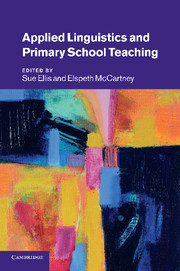Book contents
- Frontmatter
- Contents
- List of figures
- List of tables
- Notes on contributors
- Preface
- Editors' notes and conventions
- Introduction
- Part I Policy and diversity in the twenty-first-century primary school
- Part II The range and focus of applied linguistics research
- Part III Empowering teachers and teachers' use of knowledge
- Introduction to Part III
- 15 Building knowledge about language into a primary teacher education course
- 16 Using the International Phonetic Alphabet to support accurate phonics teaching
- 17 Developing word-level literacy skills in children with and without typical communication skills
- 18 The development of the Speech, Language and Communication Framework (SLCF)
- 19 How to empower teachers working with children with language impairments: why a ‘just-in-time’ model might work
- 20 Communication impairment in a multilingual context
- 21 Teacher education and applied linguistics: what needs to be understood about what, how and where beginning teachers learn
- References
- Index
17 - Developing word-level literacy skills in children with and without typical communication skills
Published online by Cambridge University Press: 26 April 2011
- Frontmatter
- Contents
- List of figures
- List of tables
- Notes on contributors
- Preface
- Editors' notes and conventions
- Introduction
- Part I Policy and diversity in the twenty-first-century primary school
- Part II The range and focus of applied linguistics research
- Part III Empowering teachers and teachers' use of knowledge
- Introduction to Part III
- 15 Building knowledge about language into a primary teacher education course
- 16 Using the International Phonetic Alphabet to support accurate phonics teaching
- 17 Developing word-level literacy skills in children with and without typical communication skills
- 18 The development of the Speech, Language and Communication Framework (SLCF)
- 19 How to empower teachers working with children with language impairments: why a ‘just-in-time’ model might work
- 20 Communication impairment in a multilingual context
- 21 Teacher education and applied linguistics: what needs to be understood about what, how and where beginning teachers learn
- References
- Index
Summary
Introduction
Words have power. Spoken words convey meaning and intent. Without an understanding and facility with spoken words, face-to-face communication can be impeded. Written words are equally powerful. Successful reading and writing require strong knowledge of the written word. Children must know how to read words to access meaning at the word, sentence and text level. Equally important, children also must be able to spell words correctly to convey accurate and appropriate information to their readers.
In the USA, teachers provide instruction in word-level reading (i.e. decoding and recognition abilities) during the early primary years (e.g. Darling-Hammond 2000) although the amount of time focused specifically on decoding may be variable (e.g. Juel and Minden-Cupp 2000). Even less time is spent on spelling instruction. Graham et al. (2008) reported that 90 per cent of the primary-grade teachers they surveyed taught spelling. However, there was quite a bit of variability in teachers' responses, with some spending less than twenty minutes per week and a few not teaching spelling at all. It seems educators assume that children should quickly develop good word-level reading and spelling skills, and, therefore, provide little focused instruction in these areas, especially beyond the early primary years. While the majority of children acquire word-level reading with minimal instruction, a substantial number do not (Lyon 1998). Estimates are that almost 18 per cent of children in the USA encounter significant reading problems in the first three years of school (NAEP 2005).
- Type
- Chapter
- Information
- Applied Linguistics and Primary School Teaching , pp. 229 - 241Publisher: Cambridge University PressPrint publication year: 2011
- 3
- Cited by

